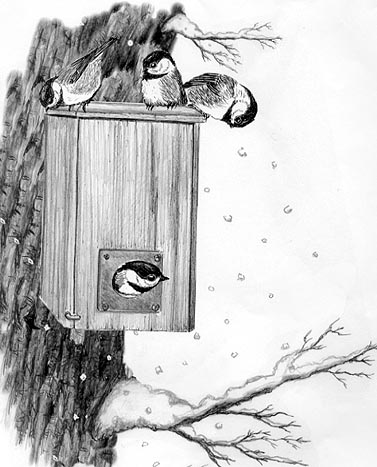
Dear Bird Folks:
I’ve heard that birds will use nesting boxes to roost in during the colder months. Would it be a good idea to put out more boxes in the winter? Also, do birds roost in flocks, and if so are the flocks mixed or do the birds only roost with the same species?
-Roy, Chatham
Hey Roy,
Can we talk? So many gossipy questions about who birds sleep with. Maybe I should pass this question on to Joan Rivers or to whoever has taken Ann Landers’ place. I’m certainly not going to ask Hedda Hopper. She’s still mad at me for passing her some bad dirt about a Lady Bird Johnson. How was I supposed to know she wasn’t a real bird?
Roosting in cavities is one of the many survival techniques birds have developed to endure the bitter cold of winter. By curling up in the hollow of a tree, birds are able to protect themselves from frigid winds. The interesting thing is that only a few birds have adopted this behavior, most sleep outside. No matter how nasty the weather gets, you won’t find birds like cardinals, Blue Jays or mockingbirds hiding out in a rotted tree stump. They would rather freeze than crawl into a dark hollow that could be filled with scary spiders.
Typically the birds who roost in tree cavities are the same birds who nest in cavities. A bluebird, that loves to build its nest in a birdhouse, will also spend a cold winter’s night in a birdhouse. Meanwhile, the bluebird’s cousin, the robin, has no use at all for any nesting box. Why? The scientist will tell you that it’s all instinct, but I think it’s because the robin is too darn fat and is afraid that it might get stuck in the hole.
Not all birds that roost in nesting cavities use them the same way. Some species are loners and will rarely shack-up with any other bird, no matter how hot it looks. Much like an old married couple, a pair of Downy Woodpeckers may spend the entire day hanging out together, but at night they find it more peaceful to sleep alone. Tree Swallows on the other hand will pig pile into a cavity for some kind of wild group sleepover and not even ask first names. Other birds like nuthatches often sleep alone but will flock up when the weather gets extra cold. Creepers will do the same thing. And I think we all know what it’s like to wake up to find a creeper sleeping next to you.
It appears from what I’ve read, Roy, most birds that roost communally in cavities, usually roost with their own species, bluebirds sleep with bluebirds, etc.. I’d imagine some birds will occasionally mix things up a bit and spend the night with some bird they aren’t supposed to be with, but they don’t talk about that very much. They don’t Hedda Hopper blab it all over town.
What surprises me is that birds don’t curl up at night with some sleeping mammal, that’s where the heat is. Wouldn’t a chickadee be better off cozying up to a snoozing bear than another shivering chickadee? Who knows, maybe some chickadees have tried to spend a night with a bear. If they have, they haven’t made it back to tell anyone.
Many other birds also roost in flocks, but they do so out in the cold. Crows and blackbirds form huge flocks. During the day young birds follow the older birds around, because adult birds are better at finding food. You would think that the older birds would scare off the younger birds in order to protect the food supply. But the adult birds know what they are doing, because at night they sleep in the middle of the flock, forcing the kids to sleep on the outer edges. By staying in the middle the older birds are insulated from both the howling winds and hungry nocturnal predators. What a great plan. I need to remember to try that the next time I take the family camping.
If you have several nesting boxes around your yard, Roy, you don’t need to put up any extra for the winter, but you should clean out any old nests that remain from the summer. You can also purchase boxes that are specially made for roosting. Roosting boxes look much like regular nest boxes but they have a series of perches on the inside for birds to sleep on and the entry hole is near the bottom, to help prevent heat loss. Just don’t expect Lady Bird Johnson to be roosting in any of them. I was way off base with that one.
